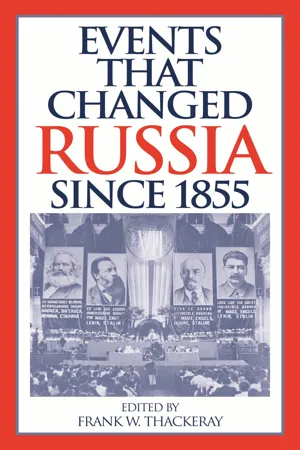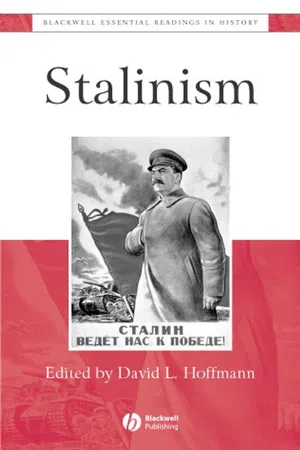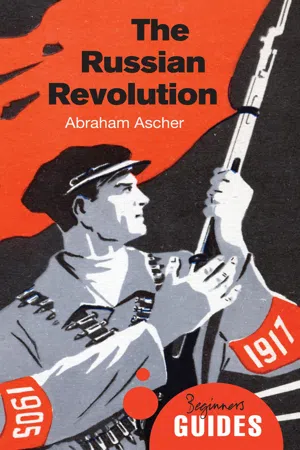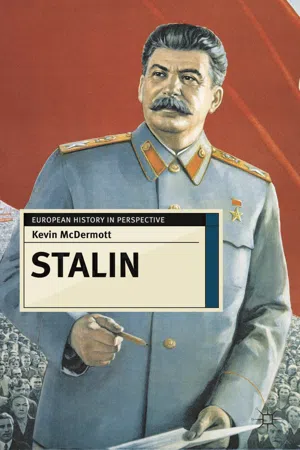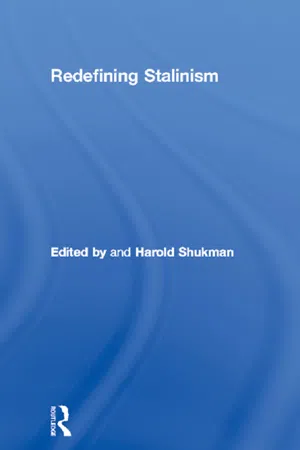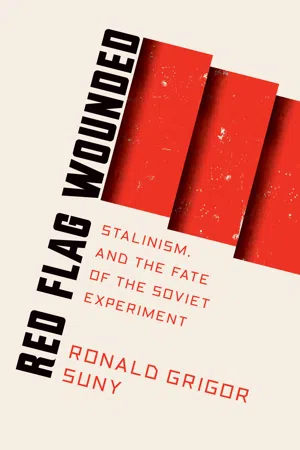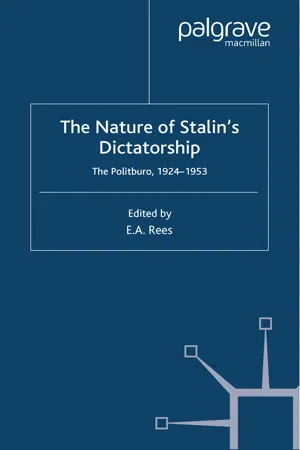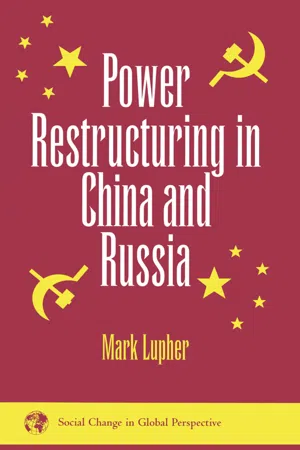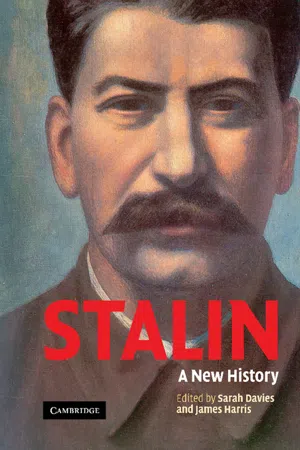History
Stalin
Stalin, also known as Joseph Stalin, was a Soviet leader who ruled the Soviet Union from the mid-1920s until his death in 1953. He implemented policies of rapid industrialization and collectivization, but also carried out purges and repression, resulting in millions of deaths. His leadership had a profound impact on the course of world history, particularly during World War II and the early Cold War period.
Written by Perlego with AI-assistance
Related key terms
1 of 5
11 Key excerpts on "Stalin"
- eBook - PDF
- Frank W. Thackeray(Author)
- 2007(Publication Date)
- Greenwood(Publisher)
7 The Stalin Era, 1928 –1953 INTRODUCTION Perhaps the most consequential figure in twentieth-century Russian his- tory was not even a Russian. Joseph V. Stalin, the Soviet-era dictator who ruled with an iron fist, was born Josip Dzhugashvili in 1879 in Gori, a small village not far from Tbilisi, the capital of Georgia, then part of the Russian Empire. He was the son of a violent, alcoholic shoemaker and a pious mother. Only after becoming an active revolutionary did he adopt the pseudonym Stalin, meaning man of steel, and throughout his life, he spoke Russian with a thick, almost unintelligible Georgian accent. Sent by his mother to an Orthodox seminary in preparation for a career as a priest, he was expelled in 1899 and soon gravitated into the ranks of the Bolsheviks. For a number of years, he labored for the Marxist cause, even going so far as to rob banks in order to fill the party’s coffers. For his pains, he was repeatedly arrested and exiled to Siberia, from where he would escape to resume his activities. Although Stalin occasionally trav- eled abroad, he was one of the few future Bolshevik leaders who did not spend significant time in European exile. When the Russian Empire collapsed in 1917, Stalin, who was in exile in Siberia, hurried back to Petrograd, where he attached himself to Vladimir I. Lenin. Characterized by humility, constancy, and retiring behavior in the midst of a unique collection of egomaniacs, Stalin was also exceptionally industrious, efficient, and thorough. Not surprisingly, 130 Events That Changed Russia since 1855 the Bolsheviks dumped considerable amounts of paperwork in his lap. One revolutionary of the time described Stalin as “a gray blur sometimes emitting a dim and inconsequential light.” During the early years of Bolshevik power, Stalin held several important but not very visible posts, most of which required seemingly Joseph V. - eBook - PDF
Stalinism
The Essential Readings
- David Hoffmann(Author)
- 2008(Publication Date)
- Wiley-Blackwell(Publisher)
4 Thus Stalinism represented a reversion to the more extreme phases of Russian autocracy, as under Ivan the Terrible or Peter the Great. And at a superficial glance this explanation seems eminently plausible. Indeed, Stalin himself liked to compare his rough nation-building with that of these two tsars, Peter for the Plan and Ivan for the Terror. Yet it would be prudent to reserve judgement on this matter until Stalin’s own record has been examined, and to seek the sources of Stalinism, in the first instance, not in remote centuries but in the actual circumstances that produced the revolution from above. Here, in this line of inquiry, Stalin’s personality is far more germane than are the ghosts of autocrats past. Even so, caution is in order on this score, too, for Stalin’s lugubrious figure, like Hitler’s equally macabre one, can easily overshadow his period and the system he represented. Thus “Stalinism” in common par-lance too often means a style of rule – an extreme personal tyranny, an exceptional despotism, or a superdictatorship – created and sustained by the man, Stalin. But these Greek and Roman terms do not do justice, any more than does the invocation of Genghis Khan, to the historical par-ticularity of the Stalin phenomenon. So Stalinism must also be viewed as a system of hyperbureaucratic and terroristic control. Yet even when this is done, the system’s genesis is still too often explained not by structural factors but by the tyrant’s overweening ambition. The consequence of this is that once the evil author of the “ism” has disappeared, the system itself may be consid-ered to have ended. Thus in both Western and Soviet usage, as we have seen, Stalinism was at times held to be a completely different phenome-non from Bolshevism and Leninism. 5 In Soviet parlance this assessment was expressed as “the cult of personality,” which meant that an other-wise sound socialism was “distorted” by the undue and accidental power of one leader. - eBook - ePub
The Russian Revolution
A Beginner's Guide
- Abraham Ascher(Author)
- 2014(Publication Date)
- Oneworld Publications(Publisher)
Both imposed absolute dictatorships on their countries, both failed to heed moral scruples in imposing their wills on the nation, and both sought to control every facet of the country’s social and cultural life, although it should be kept in mind that in none of the totalitarian countries did the political leadership fully attain its goals. A fair number of citizens in the Soviet Union, as in Nazi Germany and Fascist Italy, refused to go along with the demands of the authorities. These people held on to their own views and wherever possible courageously ignored the police of a state they considered immoral, unjust, or ineffective. Readers who find the term totalitarianism inappropriate might find the following description of the Stalinist regime more acceptable: it was a brutal, all-embracing dictatorship. In the final analysis, for the student of the Soviet Union it is important to understand how it functioned, not the name that scholars assign to it. Stalin was the undisputed leader of the Soviet Union. He controlled the Communist Party, the single most powerful institution for implementing his economic and cultural policies. He controlled the army, as well as the dreaded secret police, and he acted as arbiter of disputes over ideology and cultural issues. He was not a flamboyant ruler in the style of Hitler or Mussolini, but he knew how to promote his cult of personality. His photograph appeared in numerous locations throughout the Soviet Union. Although he did not issue a formal edict claiming infallibility, his word—on politics, art, films, literature, and even science—was taken by many people to be indisputable - eBook - PDF
Stalin
Revolutionary in an Era of War
- Kevin McDermott(Author)
- 2006(Publication Date)
- Red Globe Press(Publisher)
Chapter 6: Statesman Stalin emerged from the immense stresses and strains of the ‘Great Patriotic War’ immeasurably strengthened. Proclaimed as the indefatigable infallible ‘Generalissimo’ who had ensured victory over the barbarian Teutonic hordes, he enjoyed, arguably for the first time, buoyant levels of popular support. The regime had proven its ability to survive the supreme challenge of Hitler’s ‘war of annihilation’, the most destructive in history. The impera-tive to expel the invader had forged a certain national unity between people and government and in this sense the successful prosecution of the war more than any other single factor legitimised the Stalinist system and Stalin himself as undisputed vozhd’ . The dilemma facing the triumphant leader-ship after May 1945 was how best to reconstruct the shattered Soviet eco-nomy and society, while safeguarding the sole socialist bastion in an unpredictable international climate. In theory at least, the relatively moder-ate wartime policies could have been continued both at home and abroad and it is possible that some in the party-state elites favoured measured reform. For Stalin, however, this was anathema and soon the regime re-verted to increased repression and state intervention, severely testing its citizens’ new-found loyalty and tentative trust. On the domestic front, the period 1945–53 is normally designated as the era of ‘High Stalinism’, a stiflingly bureaucratised, centralised and personalised form of rule in which political and social stability, cultural uniformity and rapid economic recov-ery were the order of the day after the turmoil of war. On the diplomatic scene, these years witnessed the gradual degeneration of East-West relations into what became known as the Cold War. The USSR was transformed into the second global superpower, its military and industrial might eventually rivalling that of the USA. A Soviet dominated socialist bloc was created in the lands of Central and Eastern Europe. - eBook - PDF
Totalitarian Societies and Democratic Transition
Essays in Memory of Victor Zaslavsky
- Tommaso Piffer, Vladislav Zubok, Tommaso Piffer, Vladislav Zubok, Riccardo James Vargiu(Authors)
- 2017(Publication Date)
- Central European University Press(Publisher)
The results of Stalin’s Dictatorship 181 Stalin’s politics in the final years of his regime—which, judging from certain facts, were marked by a profound systemic crisis—are almost entirely ignored. The manifestation of this crisis was the main reason Stalin’s successors immediately refused to continue carrying out the most odious aspects of his system. Only a country as rich in natural and human resources as the Soviet Union could physically withstand “modernization” in the Stalinist variant, and—to use a subtle metaphor—not only pay the “price” of its socio-economic experiments, but actually yield visible results. How-ever, the importance of these results was mostly strategic. According to an aphorism widely circulating in contemporary Russia, attributed to Churchill (who, incidentally, never said such a thing), Stalin took over the country when it was still using the wooden plow and left it equipped with atomic weapons. In truth, Stalin left Russia with both atomic weapons and the wooden plow, which is precisely why the strategic model of “modernization” created by Stalin was doomed to failure. The hypertrophy of the repressive state generated by Stalinist politics, an economic relations system that rejected efficiency and innovations, and many other factors left a long-lasting mark on the development of the country, which was condemned to reproduce an ever-delayed model for advancement. All the facts that are now known make it possible to recognize beyond a shadow of a doubt that the Stalinist dictatorship was an extremely violent political regime, capable of reaching its goals mainly by way of terror and abuse. Becoming aware and acknowledging this basic fact must be the starting point for the further development of research on the other key aspects of the Stalinist system. First among these is the issue of the relative autonomy of social processes, and the considerable diffusion of social phenomena opposing the dictatorship. - eBook - ePub
- Harold Shukman(Author)
- 2004(Publication Date)
- Routledge(Publisher)
The monolithic Stalinist government is a myth’. 32 But only a few lines later he adds, ‘The totalitarian state…has encompassed the entire economy of the country as well. Stalin can justly say… “La Société, c’est moi”’. 33 Such a lapse would normally be attributed to Trotsky’s penchant for the sweeping historical metaphor. In the case of his biography of Stalin, from which these lines are taken, there is often an additional reason given: Trotsky was ‘too close to the subject’; his normally lucid train of thought hindered by his personal involvement in the events that led to his own catastrophic political end. 34 This curiosity, especially when viewed in light of later writings by a host of scholars from a variety of points on the political spectrum, but who all exhibit a similar tendency, can most fruitfully be described as a form of ‘historical parallax’, with the apparent change in the position and nature of the object— Stalin—actually being caused by a change in the position of the observer. Employing a static frame of reference, the resulting inconsistency can hardly be avoided. This phenomenon is summed up best by McAuley when she likens the ‘Stalinist’ view of Stalinism to that put forward by the totalitarian school: Both depicted the Soviet period from 1917 to 1953 as one in which aims remained unchanged, both saw the party as somehow still the same party because its ‘ideology’ (that is, the rhetoric of Marxism-Leninism) remained the same; both emphasized the guiding nature of something called ‘Marxist-Leninist ideology’ and granted Stalin almost superhuman powers of control over society. 35 In a chapter devoted to the ‘Social Ingredients of Stalinism’, Pethybridge shows how severely the parallax view—and in his case multi-parallax—can hamper an assessment of the subject - eBook - ePub
Russia
A Short History
- Abraham Ascher(Author)
- 2017(Publication Date)
- Oneworld Publications(Publisher)
To imbue factory employees with the necessary work habits, early in the 1930s, the government introduced a rigid system of discipline. For example, factory managers controlled the issuance of ration cards, which until 1935 were required for the purchase of food and manufactured goods. Workers dismissed from their jobs for one or another reason would lose their card and might also lose their place of residence, which was under the control of the enterprise. After 1932, factory managers were directed to dismiss and deprive of their housing any workers absent from their job without good reason for just one day. The growing intrusion of the state in the affairs of the citizens was an integral aspect of Stalin’s revolution from above and thus marked the beginning of a new political system, totalitarianism.TOTALITARIANISMThe term ‘totalitarianism’ has come under considerable criticism. Many scholars consider it a term of opprobrium coined during the Cold War as a weapon with which to stigmatize the Soviet Union. In fact, the word was already in use in the 1930s and the person who popularized its usage was none other than Benito Mussolini, the Fascist dictator of Italy. Mussolini was proud to be striving for the establishment of totalitarianism in his country, by which he meant a polity in which the state seeks to control every facet of economic, social, and political life. In this sense, Russia under Stalin became totalitarian, for the government sought to secure total control over national institutions and over the people’s affairs, private as well as public, even though it did not fully succeed in achieving its ultimate goal.A brief sketch of Stalin’s system of rule in the 1930s will demonstrate this. But first it may be instructive to touch upon another vexing issue in modern Russian history, the relationship between what are now known as Stalinism and Leninism. Put differently, was Stalinism a mere continuation of Leninism, or did the two represent quite different polities? Scholars who take the latter position argue that Lenin was far more pragmatic and tolerant and much less ruthless than Stalin. They also argue that Lenin would probably have continued the New Economic Policy and almost certainly would not have embarked on so radical a program as the Five Year Plan and collectivization. There may be some merit to this line of reasoning, but it should not be forgotten that Lenin resorted quite freely to terror during his period in power and that War Communism, his creation, was also an extraordinarily harsh social and political system. Moreover, throughout the eleven years of Bolshevik rule before Stalin’s ascendancy there was no legal order in the Soviet Union. The best evidence for this is the Criminal Code of 1922, which adopted the essence of Lenin’s draft of a statement on governmental discretionary power. It stated that any action – be it merely propaganda, agitation, or support of anti-communist organizations – by a citizen ‘helping in the slightest way that part of the international bourgeoisie’ that is committed to overthrowing the communist system is ‘punishable by death or imprisonment’. So vague a formulation is a citizen’s nightmare and a policeman’s dream. There can be little doubt that Lenin’s legacy, ideological as well as institutional, helped pave the way for Stalinism. The terror, the absence of a legal order, and rule by a hierarchically organized party not only facilitated Stalin’s rise to power but also constituted central features of both Leninist Bolshevism and Stalinism. - eBook - ePub
Red Flag Wounded
Stalinism and the Fate of the Soviet Experiment
- Ronald Suny(Author)
- 2020(Publication Date)
- Verso(Publisher)
vintiki (little screws) who had their own requirements for survival and “making out.” The state grew; in Moshe Lewin’s sense, it “swallowed” society; but, at the same time, it was unable to realize the vision presented by a totalitarian theory of complete atomization of society. The limits of state power were met when people refused to work efficiently, migrated from place to place by the millions, or informally worked out ways to resist pressure from above. Totalitarian control may have been an ambition of Stalinism, but the dark aim of atomization of an impotent, obedient, terrified people was never achieved.Stalin came to power in the absence of a broad consensus on the legitimacy and necessity of his personal rule. Using the instruments of state power to mobilize people in a grand program of social transformation, the regime confidently conceived of itself as possessing a popular and historically sanctioned mandate and worked assiduously to increase support for itself through education and propaganda, leadership cults, election campaigns, broad national discussions (on the constitution and other topics), public celebrations (like the Pushkin centennial of 1937), the creation of celebrity heroes (aviators, arctic explorers, and exemplary workers), show trials, and political rituals.38 Most important, the party/state made real concessions to the populace and satisfied the ambitions and aspirations of many (though certainly not all) for social mobility and an improved living standard. Peasants who became workers and workers who became managers and party bosses were moving up, while many of their envied social “betters” of the past were experiencing an enforced downward mobility.39In the Stalinist formulation, the “revolution from above” of the 1930s, though initiated by the state, was supported from below by millions of peasants and workers struggling to create a new society based on collective farms and socialist industry. The state-initiated industrialization of the 1930s mobilized millions of men and women into the most mammoth building project in modern times, and a romance of dams and power stations, new cities on the steppe and in Siberia, created enthusiasts among the new workers and managers. The enormous difficulties that the breakthrough into “socialism” entailed—resistance from farmers, famine, economic bottlenecks and breakdowns—were seen as the work of enemies and saboteurs, rather than inherent in the party’s policies or a by-product of popular recalcitrance and massive coercion. Though the disjuncture between these forced images of imagined harmony and purpose and the hardships and dislocations of actual worksites created unease among many who attempted to govern a vast country, the sheer scale of the transformation and its construction as a human epic engendered the broad social support that the regime had sought for two decades.40 Collectivization of peasant lands was fiercely resisted, but industrialization, for all its hardships, was enthusiastically embraced.41 - eBook - PDF
The Nature of Stalin's Dictatorship
The Politburo 1928-1953
- E. A. Rees(Author)
- 2003(Publication Date)
- Palgrave Macmillan(Publisher)
The collective provided him with 234 Stalin as Leader, 1937–1953 E. A. Rees 235 a degree of immunity, by spreading responsibility for policy. It was also a mechanism for controlling subordinates, who were not only his aides but also potentially his greatest rivals. The Communist Party was the basis of Stalin’s unique personal authority in the USSR, and in the inter- national communist movement it was the guarantee that his legacy would survive, and that the succession could be organised in an orderly way. It was the ideology and the movement that would vindicate him historically. In this, Stalin shared much with other great ideocratic dictators and despots of the twentieth century. The core group of leaders that formed around Stalin in the 1920s was supplemented by a younger generation of leaders after 1938. But the manner of Stalin’s interaction with these subordinates also changed. Stalin preferred to work as part of a group, drawing on their ideas and suggestions, but where his authority was unquestioned. From 1937, Stalin exercised despotic power, shaping all major policy changes, and a great many of the very minor ones as well. It required people of strong will and nerve to stand up to him in policy disputes. It was a situation stacked in Stalin’s favour. Despotic power, as always, is both tempered and heightened by the fear of a palace coup and assassination. Even despotic power, we discover, is never absolute. The transition to a dictatorial and despotic rule was always condi- tional. The tension between the single ruler and his subordinates can never be eliminated. Catastrophic policy failure casts aspersions on the leader’s judgement. When Stalin was absent, the tendency was to seek, either through factional alliances or through collective action, mecha- nisms to influence policy. Stalin’s response was to play faction off against faction, or to use various strategies to dissolve any possibility of collective action. - eBook - ePub
- Mark Lupher(Author)
- 2018(Publication Date)
- Routledge(Publisher)
It is certainly mistaken, for example, to speak of Stalin’s interest in “populist control from below.” 172 Once competing centers of official and elite power had been destroyed or neutralized and more reliable and pliable leaders put in place, the authority of the new leaders and their power over the masses was reaffirmed. Just as cultural revolution radicalism was abruptly terminated in June 1931, Stalin in October 1937 condemned radical “excesses,” declared it wrong to persecute all leaders, and decreed that since the Soviet management cadre and intelligentsia were now of proletarian origin, they deserved the trust of the Soviet people. 173 But power relations had been fundamentally transformed by the late 1930s. The Great Purges targeted most explicitly the Soviet political elite that had come to power in the 1920s and grown mighty in the course of collectivization and industrialization. 174 As these high-ranking political, economic, and military officials were either destroyed or forcibly subjugated to a highly concentrated amalgam of Stalinist personal rulership, police power, and central ministerial hegemony, the dependent and uncertain position of all Soviet elites was underscored once and for all. As I discuss in Chapter 5, curbing the autonomy of officialdom and preventing the emergence of competing centers of power were perhaps the most important political aims of what Seweryn Bialer termed the “mature Stalinist system.” 175 Yet in the decades following Stalins death, the contest between Soviet rulers and Soviet elites would be renewed and their relationship redefined, this time with very different results. Notes 1 Carl J - eBook - PDF
Stalin
A New History
- Sarah Davies, James Harris(Authors)
- 2005(Publication Date)
- Cambridge University Press(Publisher)
9 Stalin as Marxist: the Western roots of Stalin’s russification of Marxism Erik van Ree Introduction There exists an extensive scholarly literature highlighting the impact of Russia’s national traditions on the Stalinist state and society. The present article focuses on ideology, understood as a body of interconnected ideas providing a comprehensive view of the actual and desirable state of society. 1 As a rule, scholarly literature is more interested in the Stalinist transformations of the real world than in the dictator’s dogmatic pro- nouncements. Nevertheless, there exists a rough consensus that Stalin substantially russified Marxist ideology. Assuming that the Russian tradi- tion powerfully influenced Stalinist realities, this is what we would expect. It goes against common sense for state ideology to have remained unaf- fected when state policies and everyday social realities have not. Not only in his day-to-day practice of power, but in his ideology, too, Stalin adapted himself to the authoritarianism, bureaucratic etatism, and patri- otism that were important elements in the Russian political tradition. However, on a closer look the consensus on Stalin’s russification of Marxism is rather shallow. Some authors hold that the dictator did indeed impose a drastic shake-up of Marxist ideology. But others dis- agree, arguing that he did not change all that much in the existing ideology itself, and that to look in that direction would be to miss the point. The real change lay in his style of presentation and in the ideology’s new function of legitimising his dictatorship. On a close examination of official dogma and formulas, one finds Stalin basically repeating I want to thank Mark Tauger for suggesting the title of this paper, and David Brandenberger for making me think again about the problem of causality.
Index pages curate the most relevant extracts from our library of academic textbooks. They’ve been created using an in-house natural language model (NLM), each adding context and meaning to key research topics.
